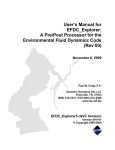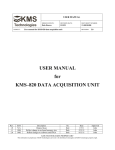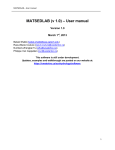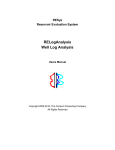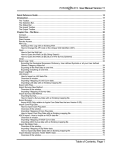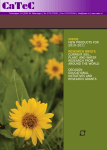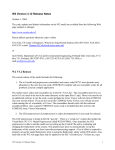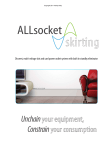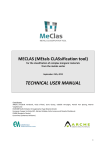Download x - KMS Technologies
Transcript
KMS Technologies KJT Enterprises Inc. Office: 6420 Richmond Ave, Suite 610 Houston, Texas 77057, USA Tel.: 713.532.8144 Fax: 281.293.7776 Headquarter: 1303 Warwickshire Dr. Houston, Texas 77077, USA Tel.: 281.293.8144 Fax: 281.293.7776 www.KMSTechnologies.com Frequently Asked Questions (FAQ) 1. Cutting sample selection: a. Cuttings are usually very small from the PDC drill bit, so it is very difficult to distinguish the actual cuttings from the reservoir formation. How to handle this problem? The technology provides reliable results for cutting size S>1mm. Topology of the porous media can not be adequately presented on particle size S< 1 mm with filtration radius R>20 microns. b. If we do not select and separate the specific rock cutting samples from the mixed cuttings on the drilling site, can we measure the percentage of different rock cuttings from the mixed cutting samples? Does the software have such functionality? No only for petrophysical parameters of reservoir rock (in current software). For determination of the percentage of different rock cuttings (size) you can use routine grain size analysis. For mineralogical analysis you can use a portable XRD devices. We cannot differentiate rocks according to their litholigical indexes (sandstone, limestone, clay etc.) by MR-ML system in current version. You can do it with portable XRD tools. We solved the problem related to determination of the clay and siltstone contents by NMR before for one of our customers. Similar R&D project are available upon request. If our customer would like to create portable complex NMR + XRD, we can provide us with appropriate portable XRD tool for it. c. Do we collect the drilling mud sample at the wellhead? Do we need to remove the sand from the drilling mud (remove cuttings by sieving the mud)? Are we going to lose the gas component after vibrating sieve? If you would like to investigate properties of the drilling mud during the drilling process (for example: stability of the mud quality) – yes, you can do it (but not needed for drill cuttings). You have to collect the drilling mud sample at the wellhead and use the MR-ML System for these purposes. Yes, you have to remove the sand from the drilling mud. Yes, as usual you will lose the gas component after vibrating sieve. d. When we measure the drilling mud sample, do we use the spectrum characterization to describe the different fluid and additives in the drilling mud? Can we quantify the different fluid and additives? If the additives have its unique NMR “mask” (signature/template/image-spectrum) you will be able differentiate them from mud sample spectrum. If MR-ML software cannot do it directly by one run measurement, then we can try to solve the problem by appropriate mud treatment before NMR measurements (two run procedure). CONFIDENTIAL C:\Documents and Settings\All Users\Documents\Kurt_pc_travel\Projects\NMR & Ecotek\product material\FAQ_MR-ML.doc 10/14/03 2:59 PM KMS Technologies page 2 of 2 As a minimum, we can separate signal from hydrocarbons and water. Ability to identify any other additives must be investigated separately. 2. Software, data processing and interpretation problems: a. Please provide detailed description and functionality of data processing software. See training presentation b. Before the data processing and interpretation, do users have to spend a lot of time to create spectra database based on their own geology environment for the interpretation? No, but if you have some specifics, related to the mineralogical composition of your sediments (paramagnetics, magnetic minerals etc) then you have to provide fine tuning of interpretive models for interpretation (petrophysical) part of the software. c. Can KMS provide the software structure and detailed user manual? Yes, we can. The formal manual will be available shortly as it is going through major revisions. Presently, there are two software units: relaxometer acquisition and data processing. d. Will KMS provide software maintenance and upgrade to users? How long KMS can provide the software maintenance and upgrade services to users? Software upgrades are included in the purchase price for a period of one year. Subsequently software and hardware maintenance and telephone support will be 11% of purchase price per annum. Any upgrades related to specific customer goals and related to the unusual situation with petrophysical interpretation can be handle as separate special service contract. 3. Technology application problems: a. For carbonate area, what can MR-MLTM system do? Do we have successful examples? System was developed and prepared for clastic (terrigeneous) reservoirs. MR-MLTM system was tested on number of carbonate samples (pilot experiments) with promising positive results. This version of software does not include any petrophysical models for carbonates. b. How close of the porosity and permeability of fractured carbonate reservoir derived from MR-MLTM system to the laboratory measured value? Do we have special requirement to such carbonate cutting samples? Filtration Capacity Properties (porosity, permeability etc.) of carbonate reservoirs are significantly dependent on results of diagenesis. This kind of information is not presented in drill cuttings with particles size less than 6.35 mm and in this case cannot be delivered by MR-ML System. c. Apart from the two successful examples described in the technical notes, can we provide a more detailed and comprehensive summary of all the successful application examples? This summary will provide more confidence for users to accept this new technology. No, other released examples exist at the moment (lots of unreleased though). 2 CONFIDENTIAL C:\Documents and Settings\All Users\Documents\Kurt_pc_travel\Projects\NMR & Ecotek\product material\FAQ_MR-ML.doc 10/14/03 2:59 PM


